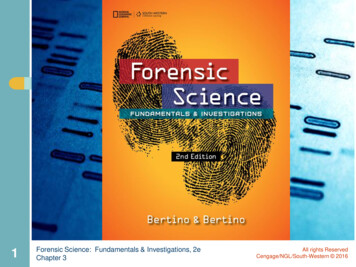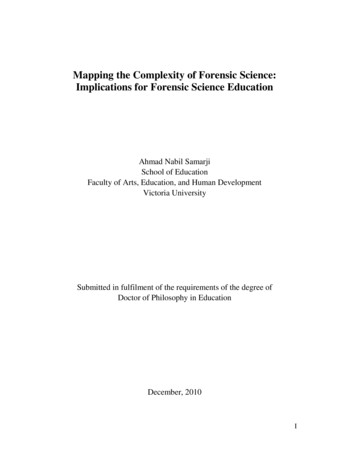
Transcription
1Forensic Science: Fundamentals & Investigations, 2eChapter 3All rights ReservedCengage/NGL/South-Western 2016
Csi case 2 http://forensics.rice.edu/ Kahoot review 4ac1e4d6ec26 FF northern exposurehttps://www.youtube.com/watch?v mYtPJoxF0Wk FF conviction overturned with a hairhttps://www.youtube.com/watch?v 3JjevVi1ycU FF hair of the dog https://www.youtube.com/watch?v uTdwoRMF20 FF beaten by a hairhttps://www.youtube.com/watch?v 0SKDCq4ojd8Forensic Science: Fundamentals &Investigations, Chapter 32
Chapter 3 Hair AnalysisBy the end of this chapter you will be able to:3.1 Identify the various parts of a hair.3.2 Describe variations in the structure of themedulla, cortex, and cuticle.3.3 Distinguish between human and nonhumananimal hair.3.4 Determine if two examples of hair are likelyto be from the same person.3Forensic Science: Fundamentals & Investigations, 2eChapter 3All rights ReservedCengage/NGL/South-Western 2016
Chapter 3 Hair AnalysisBy the end of this chapter you will be able to:3.5 Explain how hair can be used in a forensicinvestigation.3.6 Calculate the medullary index for a hair.3.7 Distinguish hairs from individuals belongingto broad racial categories.4Forensic Science: Fundamentals & Investigations, 2eChapter 3All rights ReservedCengage/NGL/South-Western 2016
Chapter gaschromatographyhair follicleooooooForensic Science: Fundamentals & Investigations, 2eChapter 3hair shaftkeratinmedullamelanin granulesmitochondrialDNA (mtDNA)nuclear DNAAll rights ReservedCengage/NGL/South-Western 2016
Introductionoooo6A hair without the follicle and its nuclear DNAcannot provide individual evidence.Hair can yield class evidence.Chemical tests performed on hair can revealdrugs, toxins, heavy metals and nutritionaldeficiencies.mtDNA from hair can reveal some of asuspect’s or victim’s family relationships.Forensic Science: Fundamentals & Investigations, 2eChapter 3All rights ReservedCengage/NGL/South-Western 2016
7Forensic Science: Fundamentals & Investigations, 2eChapter 3All rights ReservedCengage/NGL/South-Western 2016
History of Hair Analysiso 1883: Alfred Swaine Taylor and ThomasStevenson covered hair in a forensic sciencetext.o 1910: Victor Balthazard and Marcelle Lambertpublished a comprehensive study of hair.o 1934: Dr. Sydney Smith, analyzed hairs side byside using a comparison microscope.o Today: Standard procedures of hair analysisinclude microscopic examination and DNAanalysis.8Forensic Science: Fundamentals & Investigations, 2eChapter 3All rights ReservedCengage/NGL/South-Western 2016
Biology of HairHair is composed of the protein keratin, which isalso the primary component of finger and toenails.Hair is produced from a structure called the hairfollicle. Humans develop hair follicles duringfetal development, and no new follicles areproduced after birth.Hair color is mostly the result of pigments, which arechemical compounds that reflect certain wavelengths ofvisible light.Sources: tm#t hair & edric1.htm#Index%20(Hairs)
The Functions of HairoRegulates body temperatureoDecreases frictionoProtects against sunlightoActs as a sense organHumans are born with about 5 million hairfollicles.o10Forensic Science: Fundamentals & Investigations, 2eChapter 3All rights ReservedCengage/NGL/South-Western 2016
The Structure of Human Hairo11Hair consists of (a) a hairshaft produced by (b) afollicle embedded in the skin.Forensic Science: Fundamentals & Investigations, 2eChapter 3All rights ReservedCengage/NGL/South-Western 2016
The Structure of Human Hair(continued)oThe hair shaft is made upof three layers: 12An inner medullaA cortexAn outer cuticleForensic Science: Fundamentals & Investigations, 2eChapter 3All rights ReservedCengage/NGL/South-Western 2016
Hair StructureHair is composed of three principal parts:Cuticle – outer coating composed of overlapping scalesCortex – protein-rich structure aroundthe medulla that contains pigmentMedulla – central core(may be absent)The structure of hair has been compared to that of a pencil with themedulla being the lead, the cortex being the wood and the cuticleScience:& Investigations, 2ebeing Forensicthe paintonFundamentalsthe outside.All rights ReservedChapter 3Cengage/NGL/South-Western on.htm#t hair
The Structure of Human Hair(continued)oThe cuticle is atransparent outerlayer of the hair shaft. The cuticle varies in: 14Its scalesIts thickness, andWhether or notcontains pigment.itForensic Science: Fundamentals & Investigations, 2eChapter 3All rights ReservedCengage/NGL/South-Western 2016
Hair StructureCortexThe cortex varies in: Thickness Color (pigment) The distribution of pigment in the cortex varies fromperson to person. Pigment, commonly, is denser nearer the cuticle Distribution of the cortex pigment is perhaps the most importantcomponent in determining from which individual a human hair mayhave come.Info: tm#t hairImage: http://www.extrapersonality.com/hair.html
Hair StructureMedullaThe medulla may vary in: Thickness Continuity - one continuous structureor broken into pieces Opacity - how much light is able topass through it It may also be absent in some species.Like the cuticle, the medulla can be important fordistinguishing between hairs of different species, but oftendoes not lend much important information to thedifferentiation between hairs from different esson.htm#t %203%20with%20caption.jpg
Types of Medulla17Forensic Science: Fundamentals & Investigations, 2eChapter 3All rights ReservedCengage/NGL/South-Western 2016
Medulla Index—Animals vs. HumansForensic Science: Fundamentals &Investigations, Chapter 318
Types of Hairooo19In humans, hair varies from person toperson, and even varies depending on itslocation on a particular person.For an individual person, hair can vary basedon its location on the body.To compensate for inconsistencies thatoccur, 50 hairs are usually collected from asuspect’s or victim’s head.Forensic Science: Fundamentals & Investigations, 2eChapter 3All rights ReservedCengage/NGL/South-Western 2016
Types of HairBuckledBluntDouble Medulla The cross section of a hair can be circular, triangular,irregular, or flattened influencing the curl of the hair. The texture of a hair can be coarse or fine. Different regions of the body on which hair can vary are (1)head, (2) eyebrows and lashes, (3) mustache and beard, (4)underarms, (5) overall body (auxiliary hair), and (6) pubic.Forensic Science: Fundamentals &Investigations, Chapter 320
Hair from Different Parts ofthe Body21Forensic Science: Fundamentals & Investigations, 2eChapter 3All rights ReservedCengage/NGL/South-Western 2016
The Life Cycle of HairoHair proceeds through three stages as itdevelops. oCatagen stage oThe hair stops growing and the follicle recedes.Telogen stage 22Anagen stageHair actively growsLasts approximately 1000 daysThe hair follicle is dormant and hair is easily lost.Forensic Science: Fundamentals & Investigations, 2eChapter 3All rights ReservedCengage/NGL/South-Western 2016
Treated HairForensic investigators sometimes can link hair from alocation with an individual. Bleaching––– disturbs the scales on the cuticle andremoves pigmentleaves hair brittle and yellowishDyeing colors the cuticle and the cortexBecause of this and because hair grows daily, a person’streated hairs will have specific characteristics in commonwith her or his lost hairs.Forensic Science: Fundamentals &Investigations, Chapter 323
Treated Hair24Forensic Science: Fundamentals & Investigations, 2eChapter 3All rights ReservedCengage/NGL/South-Western 2016
Ethnic or AncestralDifferenceso25There are some key physical characteristics that areassociated with hair of different ancestral groups.Forensic Science: Fundamentals & Investigations, 2eChapter 3All rights ReservedCengage/NGL/South-Western 2016
Animal hair and Human HairoAnimal hair and human hair have severaldifferences including: 26The pattern of pigmentationThe medullary indexThe cuticle typeForensic Science: Fundamentals & Investigations, 2eChapter 3All rights ReservedCengage/NGL/South-Western 2016
Animal Hairand Human Hair Pigmentation:– animal hair is denser toward the medulla– human hair tends to be denser toward the cuticle Banded Color Patterns:– possible in animals– not in humans Medulla: much thicker in animalsForensic Science: Fundamentals &Investigations, Chapter 327
Animal Hairand Human HairSpinousCoronalImbricate Animals: cuticle scales resemble petals(spinous) or a stack of crowns (coronal) Humans: commonly flattened and narrow(imbricate)Forensic Science: Fundamentals &Investigations, Chapter 328
Hair Cuticleso29The cuticle of the hair shaft can helpdistinguish human hair from other animalhair.Forensic Science: Fundamentals & Investigations, 2eChapter 3All rights ReservedCengage/NGL/South-Western 2016
Using Hair in anInvestigation Macroscopic investigations indicate– Length, color, curlinessPhase contrast microscopy shows– presence of dye or other treatmentsElectron microscopes yield yet more detailChemical tests– presence of various substancesExamining a hair shaft– timeline for exposure to toxinsNeutron Activation Analysis (NAA)– concentrations of substancesForensic Science: Fundamentals &Investigations, Chapter 330
Testing the Hair Follicle Microscopic assessment– Cost effective and quick Blood test– Determine blood type DNA analysis– Identification with a high degree of confidenceForensic Science: Fundamentals &Investigations, Chapter 331
Electron Microscopesoo32Electronmicroscopesdirect a beam ofelectrons at asample.Electronmicroscopesprovidemagnification of50,000 times ormore.Forensic Science: Fundamentals & Investigations, 2eChapter 3All rights ReservedCengage/NGL/South-Western 2016
Hair Examination and Testingoooo33DNA is extracted and amplified using PCR.DNA is profiled using an automated process.mtDNA can be used to establish a geneticrelationship through the mother.Suspects can be excluded if their mtDNA isnot consistent with the crime-scene mtDNA.Forensic Science: Fundamentals & Investigations, 2eChapter 3All rights ReservedCengage/NGL/South-Western 2016
Fiber EvidenceA fiber is the smallest unit of a textile material that has a length manytimes greater than its diameter. A fiber can be spun with other fibersto form a yarn that can be woven or knitted to form a fabric.The type and length of fiber used, the type of spinning method, andthe type of fabric construction all affect the transfer of fibers andthe significance of fiber associations. This becomes very importantwhen there is a possibility of fiber transfer between a suspect and avictim during the commission of a crime.Matching unique fibers on the clothing of a victim to fibers on asuspect’s clothing can be very helpful to an investigation, whereas thematching of common fibers such as white cotton or blue denim fiberswould be less helpful.The discovery of cross transfers and multiple fiber transfers betweenthe suspect's clothing and the victim's clothing dramatically increasesthe likelihood that these two individuals had physical y2000/deedric3.htm#Fiber%20Evidence
Natural FibersMany different natural fibers that come from plants and animals areused in the production of fabric.Cotton fibers are the plant fibers mostcommonly used in textile materialsThe animal fiber most frequently used in theproduction of textile materials is wool, andthe most common wool fibers originate iaperarticle naturalfibersabsorb.htm
Synthetic FibersMore than half of all fibers used in the production oftextile materials are synthetic or man-made.Nylon, rayon, and polyester are all examples ofsynthetic fibers.Cross-sectionof a man-madefiberFibers under a microscopeImages: http://www.trashforteaching.org/phpstore/product /www.jivepuppi.com/images/fiber evidence.jpg
Hair & Fiber Identification LabDirections:Your team will need to use a microscope todocument all the hairs and fibers in yourset.Write the name of the hair or fiber onthe line and then draw what you see undermedium or high power. Be sure to indicatethe power of magnification!Add a description that highlights theunique characteristics of each hair andfiber sample.Pay attention to details to help youidentify samples during the Hair & FiberChallenge activity.
Can you identify the animal hairs shown?Think About It (1) In which samples are we viewing the cuticle? How do they compare?(2) In which samples are we viewing the medulla? How do they compare?(3) What characteristics can be used to identify hair samples?
Can you identify the types of fibers shown?Think About It (1) Which samples are natural fibers?(2) Which samples are synthetic fibers?(3) What characteristics can be used to identify fiber samples?
iques/polarized/gallery/images/humansmall.jpg
Types of Animal Hairs - KeyACatBHorseCPigDHumanGEDeerFDogRabbitHRatIHuman
Types of Fibers - KeyAcrylic YarnCotton YarnNylon RopePolyester YarnRayon RopeWool Yarn
Summaryooo43Hair is a form of evidence that has beenused in forensic analysis since the late 19thcentury.Hair is a characteristic shared by allmammals and functions in temperatureregulation, reducing friction, protection fromlight, and as a sense organ.Hair consists of a follicle embedded in theskin that produces the shaft.Forensic Science: Fundamentals & Investigations, 2eChapter 3All rights ReservedCengage/NGL/South-Western 2016
Summary (continued)ooo44The shaft is composed of the protein keratin andconsists of the outer cuticle, a cortex, and an innermedulla, most of which can vary within and amongindividuals and among species. The shaft also haspigments and mitochondrial DNA.Hair varies in length, medulla type, and crosssectional shape, depending on where on the body itoriginates.Hair development is divided into three stages:anagen (growth), catagen (resting), and telogen(dormancy).Forensic Science: Fundamentals & Investigations, 2eChapter 3All rights ReservedCengage/NGL/South-Western 2016
Forensic Science: Fundamentals & Investigations, 2e Chapter 3 History of Hair Analysis o 1883: Alfred Swaine Taylor and Thomas Stevenson covered hair in a forensic science text. o 1910: Victor Balthazard and Marcelle Lambert published a comprehensive study of hair. o 1934: Dr. Sydney Smith, analyzed hairs side by side using a comparison microscope.










